Women’s fashion can be used to date old family photos? Yes, and it’s easier than you might think! So don’t despair if you have piles of pictures with no names and dates. Pull out that shoebox under your bed, put on some old-time music, and with the tips in this blog post, you’ll be matching your ancestor’s faces with their names in no time at all!
Then take that knowledge to the cemetery with the BillionGraves app and find their gravestone!
Step 1: Call Your Grannie or Your Auntie
Who gave you that shoebox full of unlabeled photos anyway? Is there someone you can call to ask who the people are in the photos? If so, that should be your first task.

Step 2: Figure Out What Type of Photo You Own
Next, figure out what type of photo you own. We’ll make it easy for you, just click HERE to read BillionGraves’ blog post about dating old family photos. This blog post will help you to determine if your picture is a daguerreotype, ambrotype, tintype, Carte de Viste, or Cabinet Card.

These are the time periods when each of these types of photographs was popular:
- Daguerreotype (c. 1839 – 1864)
- Ambrotype (c. 1854 – 1880s)
- Tintype (c. 1853 – 1930s)
- Carte de Viste (c. 1860 – 1890)
- Cabinet Cards (c. 1880s – 1890s)
You will be using this range of dates in connection with the women’s fashions worn during that time period.
Step 3: Match the Women’s Fashions
Now, study the clothes the ladies in your photo are wearing. Notice the neckline, sleeve length, waistline, fabric type and color, hats, and accessories.

Keep in mind that wealthier families would have been more likely to have the latest season’s fashions while poorer families have “made do” with someone else’s hand-me-downs or the last decade’s styles. Do the people in your photo appear to have fancy furniture, homes, or cars in the background? This can help you to determine if they were a family of means. Take in every clue.
Fashion Look-Alikes

Today’s fashion choices for women are unlimited. Do you want to wear a classic tailored suit? A plaid jumper with a jean jacket? Orange velvet bell-bottom pants? Go for it!
But there hasn’t always been such a wide variety of options for women’s fashion.

Chances are, our great-great-grandmothers wore the same style as their neighbor down the street, the teacher who lived on the other side of town, and their cousin in the next state over. In fact, they all tended to follow the fashions in the latest mail-order catalogs. And those designs often came from big cities like Paris, London, Milan, or New York.
So scroll down through these images of women’s fashions below to narrow down the time period for the clothing, hairstyles, and accessories in your old family photos.
Women’s Fashion to Date Old Family Photos: 1835 – 1841
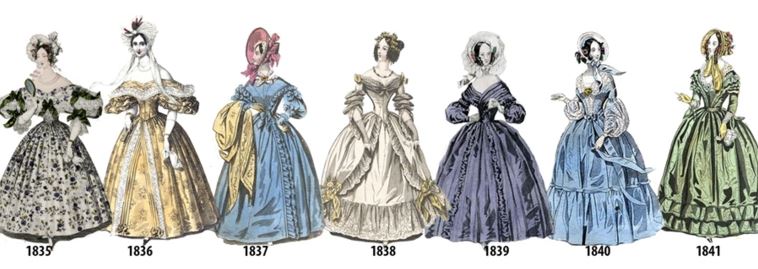
- Huge puffy sleeves
- Wide neckline to emphasize shoulder size
- Bonnets with wide semicircular brims, heavily decorated with trim, ribbons, and feathers
- Corsets pulled tight for tiny waists
- Wide-belled skirts with multiple layers of stiff tulle, lined with horsehair
Women’s Fashion to Date Old Family Photos: 1842 – 1848
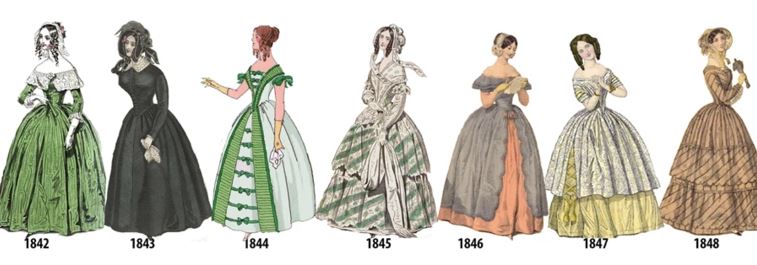
- Smaller bonnets
- Lace and ribbons dripping off the shoulders
- Hairstyles with ringlet side curls
- Black worn for an entire year when a family member died (click HERE to learn more about Victorian Era mourning clothes)
Women’s Fashion to Date Old Family Photos: 1849 – 1854
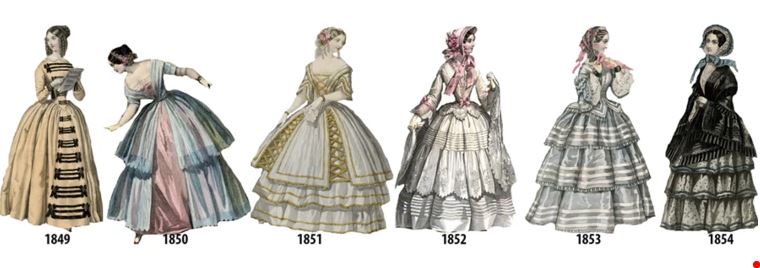
- Bell-shaped skirts, supported by crinoline petticoats
- Several layers of ruffles on the tiered skirts
- Soft shades of yellow, greenish-gold, blue, and pink
- Black for mourning dresses
Women’s Fashion to Date Old Family Photos: 1855 – 1860
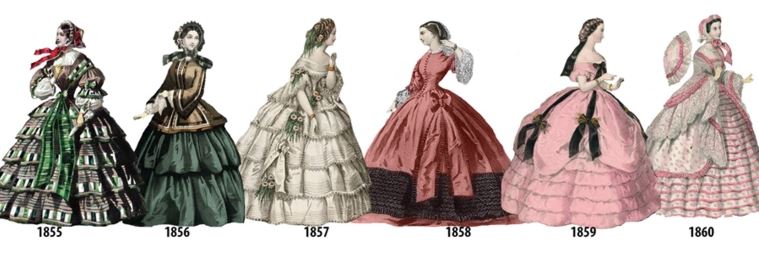
- Steel hoops, sometimes referred to as a cage, created volume for skirts
- Pink parasols, please!
- Flared sleeves
Women’s Fashion to Date Old Family Photos: 1861 – 1866
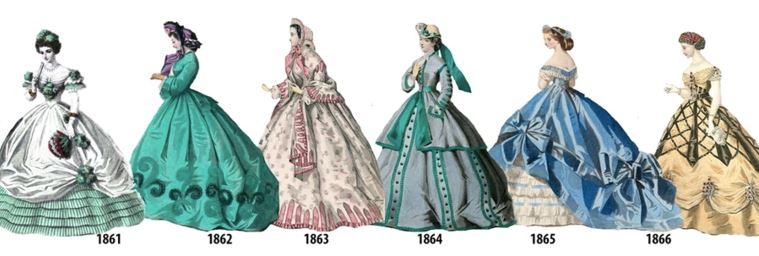
- skirts as wide as 6 feet, making it hard to sit down
- elaborate bows, ruffles, flounces, and lace on skirts
- hats were a must
- This is the time of the US Civil War (think Scarlett O’Hara dresses)
Women’s Fashion to Date Old Family Photos: 1867 – 1874
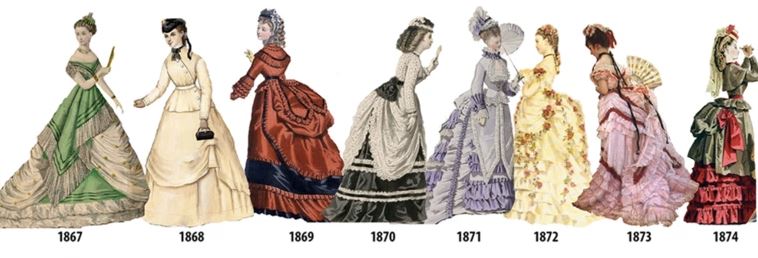
- two pieces, a bodice, and skirt, replaced connected dresses
- fans for accessories
- ringlet curls at the back of hairstyles
- bustles in back
Women’s Fashion to Date Old Family Photos: 1875 – 1882

- Wouldn’t be caught dead in a belled skirt now, streamlined dresses are in!
- Boned bodices kept the fabric from wrinkling
- Umbrellas to keep the sun from turning skin tan
- Tall hairstyles with curls piled on top or in the back
- Pleated and ruffled skirts
Women’s Fashion to Date Old Family Photos: 1883 – 1890
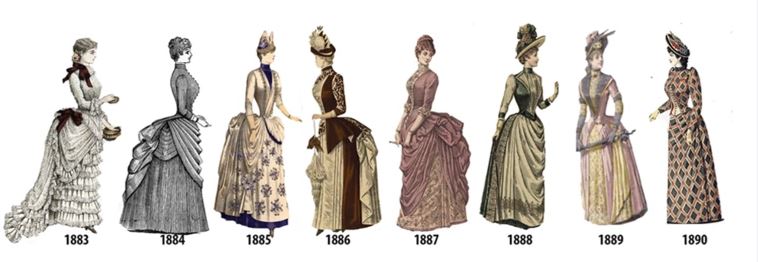
- Bustles reemerge as a popular style again
- Broad brimmed hats
- High collars with neck brooches
- Hair in chignon knots, a tight coil in the back of the head.
Women’s Fashion to Date Old Family Photos: 1891 – 1898

- Smooth skirts without ruffles
- Sleeves are high-shouldered and puffy at the top, tight from the elbow to the wrist
- Broad shoulders make waists look smaller
- Corsets were still essential
- Ostrich feathers on hats
Women’s Fashion to Date Old Family Photos: 1899 – 1907

- Hemlines dragged in a small train, giving the illusion of sweeping across the floor
- Huge hats with flowers
- Walking canes, shawls, and tiny purses for accessories
Women’s Fashion to Date Old Family Photos: 1908 – 1914

- No more corsets! Metal shortages during World War I caused full corsets to go by the wayside. They were replaced with separate girdles and brassieres.
- Department stores selling ready-to-wear clothing made it possible for more people to have a variety of outfits
- Elegant fabrics, such as silk, satin, damask, or chiffon
Women’s Fashion to Date Old Family Photos: 1915- 1921

- Shorter hemlines revealed the ankles (gasp!)
- Wide bows at the waist
- Large pointy-tipped collars
- Sports outfits as women began participating in activities like tennis and bicycling
Women’s Fashion to Date Old Family Photos: 1922 – 1929

- Flapper dress—sleeveless, knee-length, and often beaded, embroidered, or sequined
- Bobbed hair
- Headbands and bowl-shaped hats
Women’s Fashion to Date Old Family Photos: 1930 – 1938

- Figure-hugging lines
- Puffy sleeves and butterfly sleeves
- Modest necklines
- Belted waistlines
- Mid-calf flared hemlines
Women’s Fashion to Date Old Family Photos: 1939 -1946

- Knee-length dresses
- Smooth coiffed hair
- Costume jewelry and hard-sided purses
Women’s Fashion to Date Old Family Photos: 1947 – 1954

- High heels
- Gloves & belts
- Broad-brimmed hats and tiny pillbox hats
Women’s Fashion to Date Old Family Photos: 1955 – 1962

- Poodle skirts, ponytails, and jeans for teens
- Rounded shoulders
- Cinched-in waistlines
- Exaggerated hips with full skirts
Women’s Fashion to Date Old Family Photos: 1963 – 1970

- Long hair worn down or up in a “beehive” coiffe
- Shorter skirts
- Pantsuits
- Sleeveless dresses
Photos of Older Women
When using women’s fashion to date old family photographs, remember that older women often tended to wear the same style of clothing they wore in their 20s and 30s. It was what they already knew how to sew, what they were most comfortable wearing, and what they had hanging in their closet.
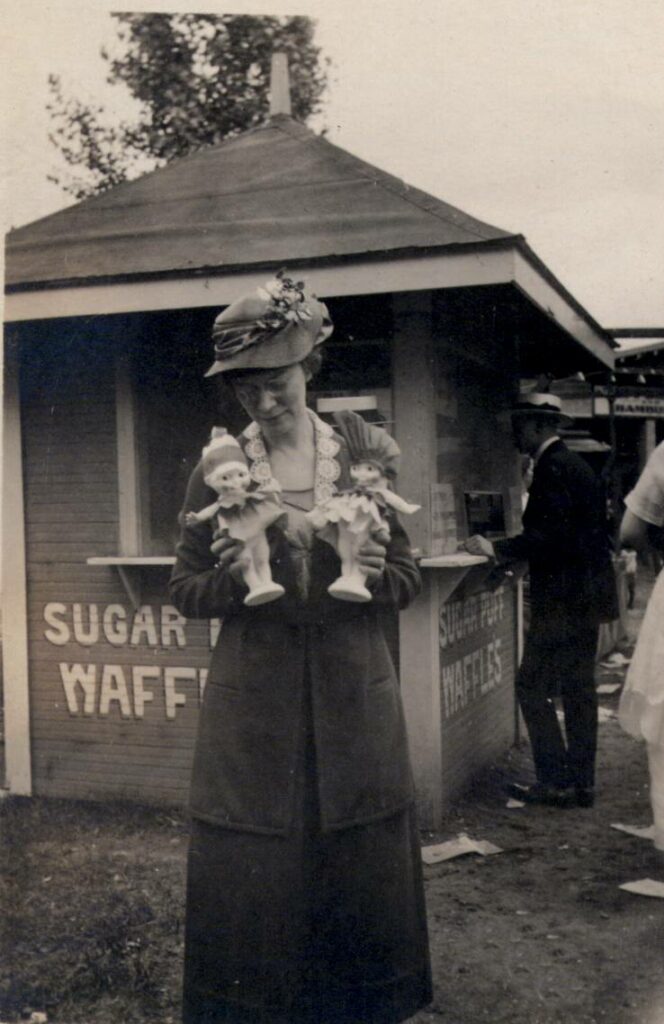
So, when dating photographs of middle-aged or older women, it is important to pay attention to other clues in the picture such as hairstyles, furniture, buildings, and toys (like these Kewpie dolls).
More Tips to Figure Out Who Is in Your Old Family Photos
- If you suspect the picture is of someone who died before 1830, it isn’t who you think it is since there were no photos of individuals prior to that date.
- Look for the photographer’s stamp at the bottom or on the back of the photograph.
- Is there a car in the photo? See if you can figure out the year it came out.

MyHeritage’s PhotoDater
One of BillionGraves’ partners, MyHeritage, has released PhotoDater™, a groundbreaking, free new feature that estimates the year a photo was taken using AI technology.

PhotoDater™ AI is trained to recognize nuances such as clothing, hairstyles, facial hair, furniture, cars, and other objects that are characteristic of a particular decade. It then calculates the estimated year the photo was taken, together with a confidence level and average error range.
You can read all about PhotoDater™ by clicking HERE.
Search a Family Tree
Next, use a family history website of your choice to enter any information you have about your ancestor and search for additional records. If you don’t already have a family tree, you might try FamilySearch. It’s non-profit and it’s free.
Include as much information as you know about the names, dates, and locations. If you don’t know the location of their birth or death, try entering the location of the photographer who took the photo.
Try to match any names that may be penciled on the backs of your photos with those on the records. Sometimes even just the first names can help you find the correct family. Try different spellings of their name using wildcards on FamilySearch.
Look for census records, land deeds, birth, marriage, and death certificates. Once you have identified the people in your family photos, try to find their headstones.
Now, Find Their Headstone!
The information and symbols on their gravestones may give you even more clues about their life, occupation, and religion. They may even help you find other family members buried nearby.
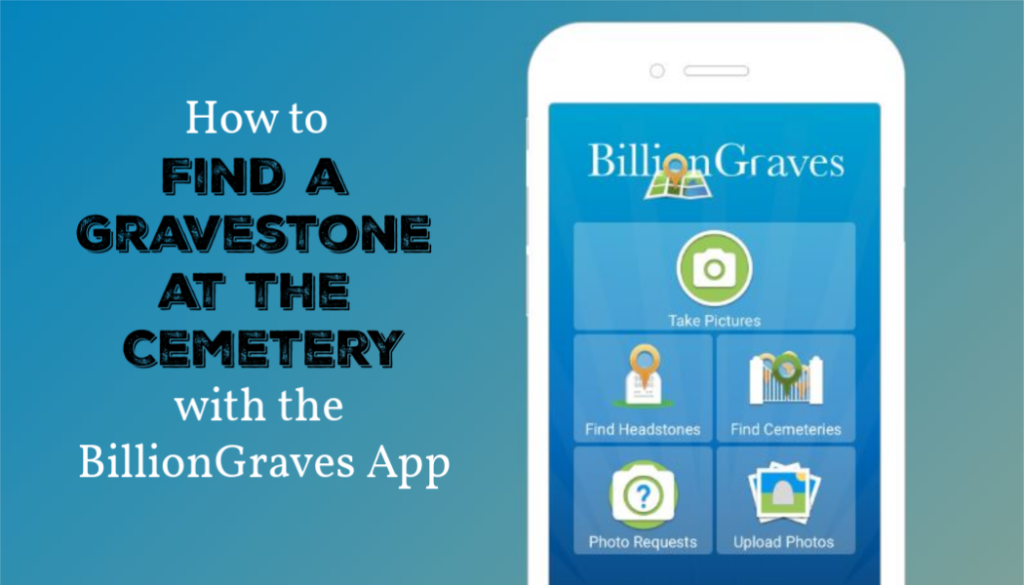
Would you believe you could go from sitting in your living room to standing in front of a particular gravestone in your local cemetery in less than 15 minutes? It’s true!
Here’s how in 10 easy steps:
- Download the BillionGraves app. Set up an account.
- From the main screen of the app, tap on “find headstones”.
- Enter a name.
- Choose one of the search results.
- Tap on “directions”.
- Drive to the cemetery.
- As you arrive at the cemetery, the BillionGraves app will show the location gravestone you looked up on the map. It will be marked with a GPS pin.
- The BillionGraves app will also display a flashing blue dot on the screen. The blue dot represents the GPS location of the phone in your hand. The blue dot will move as you walk toward the marked gravestone.
- When the blue dot and the GPS marker on the gravestone are aligned, you will be standing within a few feet of the gravestone.
- Celebrate!!
For more details on how to find a headstone in a cemetery, click HERE.
Take Gravestone Photos to Help Others Find Their Ancestors
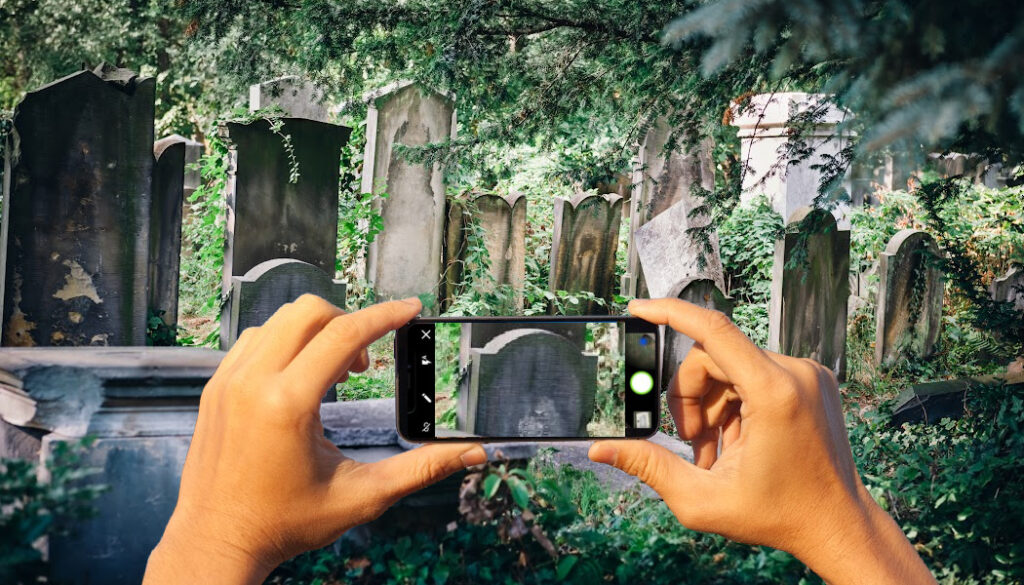
Taking photos of gravestones with the BillionGraves app on your smartphone is easy! Click HERE to get started.
You are welcome to do this at your own convenience, no permission from us is needed. If you still have questions after you have clicked on the link to get started, you can email us at Volunteer@BillionGraves.com. We’ll be happy to help you!
Are you planning a group service project? Email us at Volunteer@BillionGraves.com for more resources. We will help you find a cemetery that still needs to have photos taken.
Take a Quiz!
Let’s test your new skills! Can you use the information in this blog post to figure out which time periods the following fashions were worn?
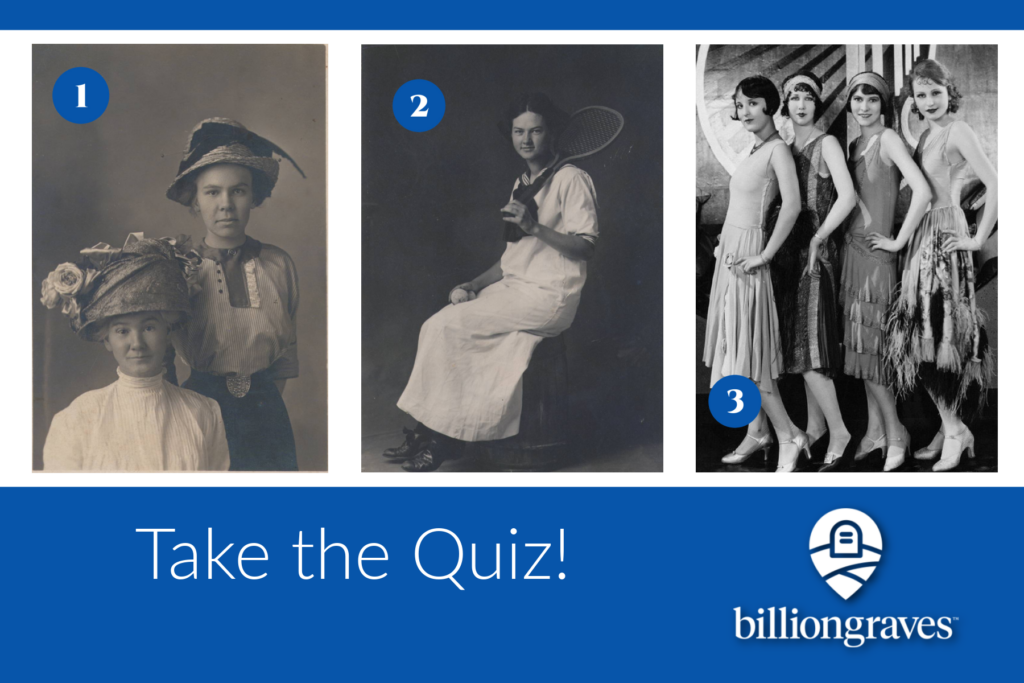
Click the button below to take the quiz.
How did you do? Jump over to BillionGraves’ Facebook page to share your score with us by clicking HERE.

And hey, do you remember that BillionGraves blog post where I mentioned that I was given some old photo albums from Denmark with lots of unmarked pictures? (You can read about them HERE.) By using women’s fashions and other clues, I was able to identify the people in almost all of the photos! Hurrah! I hope you can do the same with your unmarked photos!
Happy Cemetery Hopping!
Cathy Wallace


